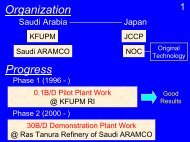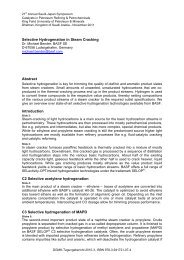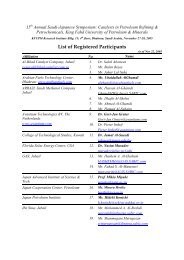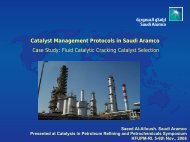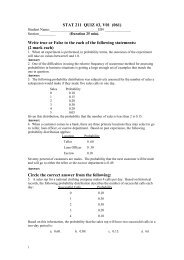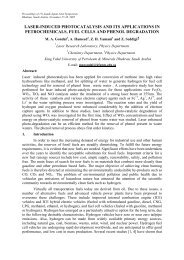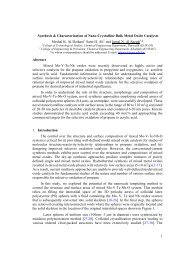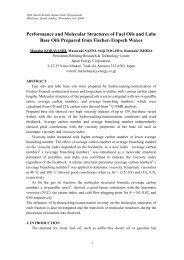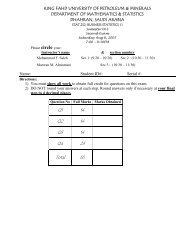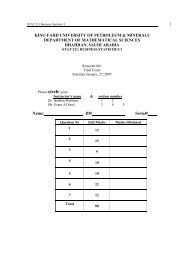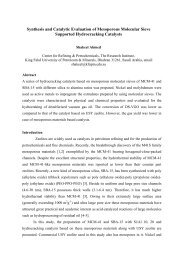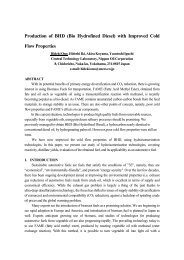High performance of Fe-K oxide catalysts for dehydrogenation of ...
High performance of Fe-K oxide catalysts for dehydrogenation of ...
High performance of Fe-K oxide catalysts for dehydrogenation of ...
You also want an ePaper? Increase the reach of your titles
YUMPU automatically turns print PDFs into web optimized ePapers that Google loves.
17th Saudi Arabia-Japan Joint Symposium<br />
Dhahran, Saudi Arabia, November 11-12, 2007<br />
<strong>High</strong> <strong>per<strong>for</strong>mance</strong> <strong>of</strong> <strong>Fe</strong>-K <strong>oxide</strong> <strong>catalysts</strong> <strong>for</strong> <strong>dehydrogenation</strong><br />
<strong>of</strong> ethylbenzene to styrene with an aid <strong>of</strong> ppm-order Pd<br />
Ryo Watanabe, Taito Hayashi, Yasushi Sekine, Masahiko Matsukata, Eiichi Kikuchi,<br />
Department <strong>of</strong> Applied Chemistry, School <strong>of</strong> Science and Engineering, Waseda University<br />
3-4-1 Okubo, Shinjuku, Tokyo, Japan<br />
Email: ekikuchi@waseda.jp<br />
Abstract<br />
Styrene is manufactured industrially through catalytic <strong>dehydrogenation</strong> <strong>of</strong> ethylbenzene on<br />
<strong>Fe</strong>-K <strong>oxide</strong>-based <strong>catalysts</strong>. It was invented by Süd-Chemie Group that the activity <strong>of</strong> the industrial<br />
ethylbenzene <strong>dehydrogenation</strong> <strong>catalysts</strong> (Styromax) based on the <strong>oxide</strong>s <strong>of</strong> <strong>Fe</strong> and K is highly<br />
promoted by the addition <strong>of</strong> small amount (hundreds ppm-order) <strong>of</strong> precious metals such as Pd. The<br />
present work is intended to elucidate the role <strong>of</strong> Pd on the <strong>Fe</strong>-K catalyst empirically by use <strong>of</strong> a<br />
periodical pulse technique from a mechanistic point <strong>of</strong> view. It was shown that styrene was <strong>for</strong>med<br />
via either <strong>dehydrogenation</strong> or oxidative <strong>dehydrogenation</strong>. The latter reaction was faster than the<br />
<strong>for</strong>mer, and it proceeded by consuming the surface lattice oxygen in the catalyst. The lattice oxygen<br />
was subsequently supplied from steam that is commonly believed to act as the diluent to reduce the<br />
partial pressure <strong>of</strong> styrene, known as a favorable effect to shift the equilibrium <strong>of</strong> volume-expanding<br />
reactions in a thermodynamic sense. Palladium added to the <strong>Fe</strong>-K <strong>oxide</strong> <strong>catalysts</strong> was found to<br />
enhance the rate <strong>of</strong> regeneration (supplying) <strong>of</strong> the lattice oxygen, although it hardly changed the rate<br />
<strong>of</strong> <strong>dehydrogenation</strong> <strong>of</strong> ethylbenzene or consumption <strong>of</strong> surface lattice O 2- anions. This study<br />
demonstrated that water molecule (steam) works not only as a diluent but also as a reactant to <strong>for</strong>m<br />
hydrogen and lattice oxygen.<br />
1. Introduction<br />
Catalytic <strong>dehydrogenation</strong> <strong>of</strong> ethylbenzene is important <strong>for</strong> the manufacture <strong>of</strong> styrene<br />
monomer, which is the raw material <strong>for</strong> polystyrene, ABS resins, synthetic rubbers, etc. <strong>Fe</strong>-K mixed<br />
<strong>oxide</strong> <strong>catalysts</strong> have been applied <strong>for</strong> <strong>dehydrogenation</strong> <strong>of</strong> ethylbenzene. The <strong>Fe</strong>-K based mixed <strong>oxide</strong><br />
catalyst can be further modified by addition <strong>of</strong> other promoters such <strong>oxide</strong>s as MgO, CeO 2 and MoO 3<br />
[1,2].<br />
Several authors have investigated the reaction mechanism <strong>of</strong> <strong>dehydrogenation</strong> <strong>of</strong> ethylbenzene<br />
on the <strong>Fe</strong>-K mixed <strong>oxide</strong> catalyst. Miura et al. [3] investigated <strong>dehydrogenation</strong> <strong>of</strong> alkylbenzenes<br />
over an <strong>Fe</strong> 2 O 3 -K 2 CO 3 -Cr 2 O 3 catalyst by means <strong>of</strong> isotope exchange experiments. According to them,<br />
dissociation <strong>of</strong> α-hydrogen is the first step followed by dissociation <strong>of</strong> β-hydrogen, which is the<br />
rate-determining step or post rate-determining step. They concluded that the α-hydrogen is<br />
1/9
17th Saudi Arabia-Japan Joint Symposium<br />
Dhahran, Saudi Arabia, November 11-12, 2007<br />
dissociated as a proton on a basic site because the exchange rate decreases in the sequence <strong>of</strong> toluene<br />
> ethylbenzene > cumene. Addiego et al. [4] examined catalyst surfaces after reaction using infrared<br />
spectroscopy. They have confirmed that styrene produced from ethylbenzene is bonded to the catalyst<br />
surface through the vinyl group.<br />
Miura et al. [5] investigated the chemical properties <strong>of</strong> active sites <strong>for</strong> <strong>dehydrogenation</strong> <strong>of</strong><br />
ethylbenzene using x-ray photoelectron spectroscopy (XPS) and x-ray diffraction (XRD). They have<br />
showed that the active surface <strong>of</strong> the catalyst is covered with K<strong>Fe</strong>O 2 which is the stable phase during<br />
<strong>dehydrogenation</strong> <strong>of</strong> ethylbenzene, in agreement with Addiego [4], Mühler [6], and Hirano [7]. Hirano<br />
[8] reported the relation between the activation energy <strong>for</strong> styrene <strong>for</strong>mation and the basicity <strong>of</strong> the<br />
catalyst. The rate <strong>of</strong> styrene <strong>for</strong>mation increased and the activation energy decreased concomitant<br />
with a decrease in electronegativity <strong>of</strong> the added transition metal <strong>oxide</strong>. Cerium <strong>oxide</strong> was found to be<br />
the best promoter <strong>for</strong> accelerating styrene <strong>for</strong>mation. Jebarathinam et al. [9] demonstrated that the<br />
desorption <strong>of</strong> styrene was the rate-determining in the case <strong>of</strong> a catalyst <strong>of</strong> weak basicity; the <strong>for</strong>mation<br />
<strong>of</strong> styrene was the rate-determining <strong>for</strong> a catalyst <strong>of</strong> weak acidity.<br />
Recently, it was reported that addition <strong>of</strong> small amounts <strong>of</strong> Pd or Pt enhances the activity <strong>of</strong><br />
<strong>Fe</strong>-K based <strong>catalysts</strong> [10]. This work is intended to clarify the role <strong>of</strong> added Pd in relation to the<br />
reaction mechanism <strong>of</strong> <strong>dehydrogenation</strong> <strong>of</strong> ethylbenzene on <strong>Fe</strong>-K mixed <strong>oxide</strong>.<br />
2. Experimental<br />
2.1. Catalysts<br />
Catalysts used in this study were <strong>Fe</strong>-K catalyst-4 (constituents: <strong>Fe</strong> 2 O 3 , K 2 O etc.) and Pd/<strong>Fe</strong>-K<br />
catalyst supplied from SÜD Chemie Catalysts Japan, Inc. The particle size was in the range <strong>of</strong><br />
0.50–0.70 mm. They were pretreated <strong>for</strong> 3 h prior to reaction under the following conditions:<br />
temperature, 873 K; H 2 O/H 2 , 12 mol mol -1 . The structure <strong>of</strong> <strong>catalysts</strong> was observed by an XRD<br />
measurement (RINT2000; Rigaku Corp.). After pretreatment <strong>of</strong> the catalyst and under working state<br />
<strong>of</strong> reaction, the predominant structure <strong>of</strong> <strong>catalysts</strong> was <strong>Fe</strong> 3 O 4 , which was not reduced further.<br />
Addition <strong>of</strong> Pd hardly changed the oxidation state <strong>of</strong> <strong>Fe</strong> in the catalyst.<br />
2.2. Apparatus<br />
The reactor used in this study comprised a quartz tube (12-mm i.d.) containing the catalyst bed,<br />
which was fixed by quartz wool. A type K thermocouple enclosed in a quartz thermowell <strong>of</strong> 3-mm<br />
outer diameter was positioned inside the catalyst bed <strong>for</strong> accurate measurement <strong>of</strong> the catalyst<br />
temperature.<br />
2.3 Activity tests<br />
Catalytic activities, selectivities, and stabilities were first examined in a conventional fixed bed<br />
flow reactor. The charged catalyst weight was 1.0 g. Reactions were carried at 873 K at atmospheric<br />
pressure in the presence <strong>of</strong> steam; the molar ratio <strong>of</strong> steam to ethylbenzene was 12 and WHSV was<br />
2/9
17th Saudi Arabia-Japan Joint Symposium<br />
Dhahran, Saudi Arabia, November 11-12, 2007<br />
1.2 g h -1 g-cat -1 . Ethylbenzene and H 2 O were fed separately using a micro feeder and a micro pump,<br />
respectively. Liquid products such as ethylbenzene, benzene, toluene, and styrene were analyzed<br />
using <strong>of</strong>f-line flame ionization detection (FID) gas chromatography (GC8A; Shimadzu Corp.) with a<br />
capillary column <strong>of</strong> DB210 (0.25 mm*30 m) using N 2 as a carrier gas at 373 K. Tetralin was used as<br />
an internal standard substance. Gaseous products such as H 2 , CO, and CH 4 were analyzed using<br />
<strong>of</strong>f-line thermal conductivity (TCD) gas chromatography (GC8A; Shimadzu Corp.) with a 3 mm*2 m<br />
stainless steel column packed with an active carbon (60/80 mesh) using Ar as a carrier gas at 393 K.<br />
2.4 Periodical pulse experiments<br />
In periodical pulse experiments, the reactants <strong>of</strong> ethylbenzene and H 2 O were supplied<br />
alternately to the catalyst bed. The period <strong>of</strong> each pulse was 600 s. The charged catalyst weight was<br />
1.0 g. Ethylbenzene and H 2 O were supplied using a bubbler with He as a carrier gas. The molar ratio<br />
<strong>of</strong> ethylbenzene to He was 1/20; the total flow rate was 7.8 * 10 -2 mol h -1 . The molar ratio <strong>of</strong> H 2 O to<br />
He was 1/8, and the total flow rate was 8.4 * 10 -2 mol h -1 . Reaction temperature was 783 K. The<br />
product composition at the reactor outlet was monitored continuously using an on-line quadrupole<br />
mass spectrometer (HPR20; Hiden Analytical Ltd.). Calibration <strong>of</strong> mass spectrometer signals was<br />
based on prepared mixtures <strong>of</strong> known composition. For all periodical experiments, the gas-phase<br />
composition was calculated from the mass signal at the following m/e 2 (H 2 ), 4 (He), 18 (H 2 O), 78<br />
(styrene), and 91 (ethylbenzene).<br />
3. Results and Discussion<br />
Activities <strong>of</strong> <strong>Fe</strong>-K and Pd/<strong>Fe</strong>-K <strong>catalysts</strong> were tested in the fixed-bed flow reactor. Figure 1<br />
shows the conversion <strong>of</strong> ethylbenzene <strong>for</strong> these <strong>catalysts</strong>. Conversion <strong>of</strong> ethylbenzene (EB) was<br />
increased from 23% to 32% by the addition <strong>of</strong> small amount <strong>of</strong> Pd. These catalytic activities were<br />
stable <strong>for</strong> 3 to 5 h at least. Selectivity to styrene (Sty) was 96% on all the <strong>catalysts</strong>. Benzene and<br />
toluene <strong>for</strong>med as by-products with selectivities <strong>of</strong> 1.7% and 2.2%, respectively.<br />
3/9
17th Saudi Arabia-Japan Joint Symposium<br />
Dhahran, Saudi Arabia, November 11-12, 2007<br />
0.45<br />
EB conversion [-]<br />
0.4<br />
0.35<br />
0.3<br />
0.25<br />
<strong>Fe</strong>-K Catalyst<br />
Pd 10 ppm/<strong>Fe</strong>-K Catalyst<br />
Pd 30 ppm/<strong>Fe</strong>-K Catalyst<br />
Pd 1000 ppm/<strong>Fe</strong>-K Catalyst<br />
Pd 300 ppm/<strong>Fe</strong>-K Catalyst<br />
0.2<br />
0 1 2 3 4 5<br />
Time [h]<br />
Figure 1. Activities <strong>of</strong> <strong>Fe</strong>-K <strong>oxide</strong> <strong>catalysts</strong> with and without Pd. Catalyst pretreatment;<br />
H 2 O/H 2 : 12 mol mol -1 , 873 K, 3 h. Reaction conditions; temperature: 813 K, catalyst weight: 1.0<br />
g, WHSV: 1.2 g h -1 g-cat -1 , steam/ethylbenzene: 12 mol mol -1 .<br />
0.45<br />
EB Conversion [-]<br />
0.4<br />
0.35<br />
0.3<br />
0.25<br />
0.2<br />
0 200 400 600 800 1000<br />
Pd content [ppm]<br />
Figure 2. Relation between the initial catalytic activity and Pd concentration. Catalyst<br />
pretreatment; H 2 O/H 2 : 12 mol mol -1 , 873 K, 3 h. Reaction conditions; temperature: 813 K,<br />
catalyst weight: 1.0 g, WHSV: 1.2 g h -1 g-cat -1 , steam/ethylbenzene: 12 mol mol -1 .<br />
Figure 2 shows the effect <strong>of</strong> Pd concentration <strong>for</strong> the initial catalytic activities on styrene<br />
<strong>dehydrogenation</strong>. From these data, the effect <strong>of</strong> the addition <strong>of</strong> Pd seems to be saturated at a few<br />
hundred ppm <strong>of</strong> Pd on the surface <strong>of</strong> catalyst. To elucidate the role <strong>of</strong> such small amount <strong>of</strong> Pd on the<br />
<strong>Fe</strong>-K mixed <strong>oxide</strong> catalyst <strong>for</strong> the ethylbenzene <strong>dehydrogenation</strong>, we carried out periodical pulse<br />
4/9
17th Saudi Arabia-Japan Joint Symposium<br />
Dhahran, Saudi Arabia, November 11-12, 2007<br />
experiments. These experiments were per<strong>for</strong>med with alternative supplies <strong>of</strong> ethylbenzene and H 2 O<br />
as described in the section 2.4. We supplied H 2 O to oxidize the catalyst reduced under<br />
<strong>dehydrogenation</strong> reaction conditions. We investigated the catalytic <strong>per<strong>for</strong>mance</strong> in the early period <strong>of</strong><br />
<strong>dehydrogenation</strong> reaction and oxidation <strong>of</strong> reduced catalyst by H 2 O.<br />
Such products as ethylbenzene, styrene, H 2 and H 2 O were detected by Q-Mass on the periodical<br />
pulse experiments. Surface lattice O 2- anions were consumed by the ethylbenzene or produced H 2 ,<br />
thereby <strong>for</strong>ming H 2 O. Figure 3 shows the fraction <strong>of</strong> H 2 O in produced hydrogen species ([H 2 O] /<br />
([H 2 ] + [H 2 O]) and the conversion <strong>of</strong> ethylbenzene when the pulse test was conducted on the <strong>Fe</strong>-K<br />
catalyst. Figure 4 shows the results <strong>for</strong> the modified <strong>Fe</strong>-K catalyst with small amount <strong>of</strong> Pd.<br />
Conversion <strong>of</strong> ethylbenzene are defined as [EB] / ([EB] + [Sty]), where EB is an abbreviation <strong>of</strong><br />
ethylbenzene, and Sty means styrene, [EB], [Sty], [H 2 ], and [H 2 O] are the amounts <strong>of</strong> these products<br />
at the reactor outlet.<br />
1<br />
Ethylbenzene feed<br />
Steam feed<br />
Ethylbenzene feed<br />
0.5<br />
Conversion , H 2<br />
O/(H 2<br />
+H 2<br />
O) [-]<br />
0.8<br />
0.6<br />
0.4<br />
0.2<br />
EB Conversion<br />
H 2<br />
O/(H 2<br />
+H 2<br />
O)<br />
EB Conversion<br />
H 2<br />
O/(H 2<br />
+H 2<br />
O)<br />
0.4<br />
0.3<br />
0.2<br />
0.1<br />
Conversion <strong>of</strong> H<br />
2<br />
O to H<br />
2<br />
[-]<br />
0<br />
0 300 600 900 1200 1500<br />
0<br />
1800<br />
Time [sec]<br />
Figure 3. Results <strong>for</strong> the periodical pulse reaction test with the <strong>Fe</strong>-K catalyst.<br />
1<br />
Ethylbenzene feed<br />
Steam feed<br />
Ethylbenzene feed<br />
0.5<br />
Conversion , H 2<br />
O/(H 2<br />
+H 2<br />
O) [-]<br />
0.8<br />
0.6<br />
0.4<br />
0.2<br />
EB Conversion<br />
H 2<br />
O/(H 2<br />
+H 2<br />
O)<br />
H 2<br />
O/(H 2<br />
+H 2<br />
O)<br />
EB Conversion<br />
0.4<br />
0.3<br />
0.2<br />
0.1<br />
Conversion <strong>of</strong> H<br />
2<br />
O to H<br />
2<br />
[-]<br />
0<br />
0 300 600 900 1200 1500<br />
0<br />
1800<br />
Time [sec]<br />
Figure 4. Results <strong>for</strong> the periodical pulse reaction test with the Pd/<strong>Fe</strong>-K catalyst.<br />
The fraction <strong>of</strong> H 2 O and the conversion <strong>of</strong> ethylbenzene showed a high value in the early period.<br />
5/9
17th Saudi Arabia-Japan Joint Symposium<br />
Dhahran, Saudi Arabia, November 11-12, 2007<br />
This steep and straight decrease <strong>of</strong> ethylbenzene conversion from 0 s to 100 s could be attributed to<br />
the domination <strong>of</strong> oxidative <strong>dehydrogenation</strong> <strong>of</strong> ethylbenzene because the ratio <strong>of</strong> H 2 O/(H 2 +H 2 O)<br />
was close to 1 at the early stage <strong>of</strong> the reaction. Oxidative <strong>dehydrogenation</strong>, by which styrene and<br />
H 2 O were <strong>for</strong>med, competed with and progressed more rapidly than, the simple <strong>dehydrogenation</strong><br />
which <strong>for</strong>med styrene and H 2 . Afterward, the conversion <strong>of</strong> ethylbenzene and fraction <strong>of</strong> H 2 O<br />
decreased and reached a steady state. Figure 5 shows the O 2- balance in the <strong>catalysts</strong> during these<br />
experiments. The amount <strong>of</strong> lattice O 2- anions that showed high reactivity is inferred to be 1.7 * 10 -5<br />
mol g -1 , which is about 25% <strong>of</strong> surface lattice O 2- anions from the BET surface area (ca. 2 m 2 g -1 ). The<br />
amount <strong>of</strong> lattice O 2- anions decreased in a straight trend in 100–600 s, implying that the<br />
concentration <strong>of</strong> surface lattice O 2- anions reached a steady state and dominated by the bulk diffusion.<br />
0.2<br />
Ethylbenzene feed<br />
Steam feed<br />
Ethylbenzene feed<br />
O 2- balance in catalyst [%]<br />
0<br />
-0.2<br />
-0.4<br />
-0.6<br />
EB<br />
600 sec<br />
Pd/<strong>Fe</strong>-K catalyst<br />
<strong>Fe</strong>-K catalyst<br />
H O 2<br />
600 sec<br />
EB<br />
600 sec<br />
-0.8<br />
0 300 600 900 1200 1500 1800<br />
Time [sec]<br />
Figure 5. Oxygen balance in the <strong>catalysts</strong> on the periodical pulse test.<br />
On the other hand, we found that the lattice O 2- anions that were consumed by ethylbenzene<br />
were regenerated by H 2 O because H 2 was <strong>for</strong>med by the reaction with H 2 O. The initial conversion <strong>of</strong><br />
H 2 O to H 2 was 20% at 600 s in figure 3, subsequently, it decreased. The rate <strong>of</strong> regeneration <strong>of</strong> lattice<br />
O 2- anions decreased from 1.7 * 10 -7 mol s -1 g -1 to 2.7 * 10 -8 mol s -1 g -1 at 740 s; then it reached the<br />
steady state. The amount <strong>of</strong> lattice O 2- anions that was regenerated be<strong>for</strong>e 740 s was 1.7 * 10 -5 mol g -1 .<br />
The amount <strong>of</strong> lattice O 2- anions regenerated while H 2 O reacted was 3.3 * 10 -5 mol g -1 , which was<br />
54% <strong>of</strong> the lattice O 2- anions consumed by ethylbenzene. The reactivity to ethylbenzene was mostly<br />
recovered by the oxidation with H 2 O.<br />
Based on results <strong>of</strong> periodical pulse experiments, we considered that the following three<br />
reactions progressed under reaction conditions with steam.<br />
(a) oxidative <strong>dehydrogenation</strong> <strong>of</strong> ethylbenzene<br />
C 8 H 10 + O 2 lattice −−> C 8 H 8 + H 2 O + 2e <br />
(b) (simple) <strong>dehydrogenation</strong> ethylbenzene<br />
6/9
17th Saudi Arabia-Japan Joint Symposium<br />
Dhahran, Saudi Arabia, November 11-12, 2007<br />
C 8 H 10 −−> C 8 H 8 + H 2<br />
(c) regeneration <strong>of</strong> lattice oxygen on the catalyst<br />
H 2 O + 2e −−> H 2 + O 2 lattice<br />
Oxidative <strong>dehydrogenation</strong> is competitive with and faster than simple <strong>dehydrogenation</strong>; H 2 O<br />
regenerates the surface lattice O 2- anions, showing high reactivity with ethylbenzene. The surface<br />
lattice O 2- anions are consumed by oxidative <strong>dehydrogenation</strong> <strong>of</strong> ethylbenzene and regenerated by<br />
H 2 O and bulk diffusion <strong>of</strong> the lattice O 2- . Previous reports have determined that the role <strong>of</strong> H 2 O is<br />
avoiding catalyst over-reduction [11]. However, in this work we consider that H 2 O has a role <strong>of</strong><br />
regenerating the surface lattice O 2- anions <strong>for</strong>ming the highly active sites.<br />
Comparing between <strong>Fe</strong>-K catalyst (figure 3) and Pd/<strong>Fe</strong>-K catalyst (figure 4), there was no<br />
appreciable difference on the conversion <strong>of</strong> ethylbenzene and the fraction <strong>of</strong> H 2 O. The rate <strong>of</strong><br />
consumption <strong>of</strong> the lattice O 2- anions on each catalyst showed the same value, which was 1.7 * 10 -7<br />
mol g -1 s -1 . The amount <strong>of</strong> the lattice O 2- anions showing high reactivity was 1.7 * 10 -5 mol g -1 , which<br />
was 25% <strong>of</strong> the amount <strong>of</strong> surface lattice O 2- anions. Consequently, we conclude that added Pd<br />
changed neither the rate <strong>of</strong> <strong>dehydrogenation</strong> <strong>of</strong> ethylbenzene nor the amount <strong>of</strong> the lattice O 2- anions<br />
giving high reactivity.<br />
On the other hand, when H 2 O reacted, H 2 was <strong>for</strong>med. The initial conversion <strong>of</strong> H 2 O to H 2 was<br />
increased from 20% to 30% by adding Pd to <strong>Fe</strong>-K catalyst at 600 s in figures 3 and 4. We found that<br />
surface lattice O 2- anions were regenerated promptly within 70 s. The initial rate <strong>of</strong> regeneration <strong>of</strong><br />
the lattice O 2- anions was increased by adding Pd to reach 3.7 * 10 -7 mol s -1 g -1 . At 670 s <strong>of</strong> run,<br />
regeneration <strong>of</strong> the lattice O 2- anions reached a steady state. The rate <strong>of</strong> regeneration <strong>of</strong> the lattice O 2-<br />
anions on Pd/<strong>Fe</strong>-K catalyst after 670 s, which was 3.8 * 10 -8 mol s -1 g -1 , was similar to that on <strong>Fe</strong>-K<br />
catalyst, which was 3.2 * 10 -8 mol s -1 g -1 . H 2 O regenerated 77% <strong>of</strong> the lattice O 2- anions consumed by<br />
ethylbenzene after steam feed <strong>of</strong> 600 sec, the amount <strong>of</strong> which was 6.1 * 10 -5 mol g -1 .<br />
These results indicate that added Pd promoted the regeneration <strong>of</strong> lattice O 2- anions by H 2 O<br />
although it does not affect the rate <strong>of</strong> <strong>dehydrogenation</strong> <strong>of</strong> ethylbenzene or the amount <strong>of</strong> the lattice O 2-<br />
anions giving a high reactivity. The amount <strong>of</strong> added Pd was 2.8 * 10 -8 mol g -1 , which was 1.6% <strong>of</strong> the<br />
surface lattice O 2- anions giving a high reactivity. We have demonstrated that adding Pd fewer than<br />
the surface lattice O 2- anions enhances the catalytic activity.<br />
This conclusion was confirmed by the further experiments by changing the amount <strong>of</strong> Pd on the<br />
<strong>Fe</strong>-K catalyst. Figure 6 shows the relationship between Pd content on the <strong>Fe</strong>-K catalyst and the rate <strong>of</strong><br />
styrene <strong>for</strong>mation/O 2- consumption. As shown here, there is no particular effect <strong>of</strong> Pd addition on the<br />
<strong>Fe</strong>-K catalyst <strong>for</strong> the rate <strong>of</strong> styrene <strong>for</strong>mation and O 2- consumption in/on the catalyst. Figure 7 shows<br />
the relation between the rate <strong>of</strong> lattice oxygen regeneration calculated by the periodic pulse<br />
experiments and the steady-state conversion <strong>of</strong> ethylbenzene observed in the continuous reactor. A<br />
linear relation between them confirms that the added Pd increases the rate <strong>of</strong> lattice oxygen<br />
regeneration in/on the <strong>Fe</strong>-K catalyst. Proposed reaction mechanism <strong>of</strong> this Pd/<strong>Fe</strong>-K catalyst <strong>for</strong><br />
oxidative <strong>dehydrogenation</strong> <strong>of</strong> ethylbenzene is shown in Figure 8.<br />
7/9
17th Saudi Arabia-Japan Joint Symposium<br />
Dhahran, Saudi Arabia, November 11-12, 2007<br />
The rate <strong>of</strong> styrene <strong>for</strong>mation and<br />
O 2- consumption [mmol sec -1 ]<br />
0.6<br />
0.5<br />
0.4<br />
0.3<br />
0.2 The rate <strong>of</strong> styrene <strong>for</strong>mation<br />
The rate <strong>of</strong> O 2- consumption<br />
0.1<br />
0 200 400 600 800 1000<br />
Pd content [ppm]<br />
Figure 6. The effect <strong>of</strong> Pd concentration on the rate <strong>of</strong> styrene <strong>for</strong>mation and O 2-<br />
consumption.<br />
EB conversion (activity tests) [-]<br />
0.5<br />
0.4<br />
0.3<br />
0.2<br />
0.1<br />
0<br />
0 0.2 0.4 0.6 0.8 1<br />
The rate <strong>of</strong> O 2- regeneration [mmol sec -1 ]<br />
Figure 7. The relation between the rate <strong>of</strong> lattice oxygen regeneration and steady-state<br />
conversion <strong>of</strong> ethylbenzene.<br />
8/9
17th Saudi Arabia-Japan Joint Symposium<br />
Dhahran, Saudi Arabia, November 11-12, 2007<br />
oxidative <strong>dehydrogenation</strong><br />
simple <strong>dehydrogenation</strong><br />
EB<br />
St + H 2 O<br />
St + H 2<br />
H 2 O<br />
H 2<br />
oxidation <strong>of</strong> catalyst<br />
H 2 O<br />
O 2-<br />
O 2- VO 2- VO 2-<br />
O2-<br />
O 2- VO 2-<br />
<strong>Fe</strong> 2+ <strong>Fe</strong> 3+ <strong>Fe</strong> 2+ <strong>Fe</strong> 2+<br />
Pd<br />
<strong>Fe</strong> 3+<br />
<strong>Fe</strong> 2+ O 2-<br />
<strong>Fe</strong> 2+ O 2- <strong>Fe</strong> 3+<br />
O 2- O 2- O 2-<br />
O 2- O 2-<br />
O2- O<br />
bulk diffusion <strong>of</strong> lattice oxygen<br />
2-<br />
VO 2- : O 2- vacancy<br />
Figure 8. Schematic image <strong>of</strong> oxidative <strong>dehydrogenation</strong> <strong>of</strong> ethylbenzene on the Pd/<strong>Fe</strong>-K<br />
catalyst.<br />
4. Conclusion<br />
We studied the effect <strong>of</strong> Pd on the activity <strong>of</strong> <strong>Fe</strong>-K mixed <strong>oxide</strong> catalyst <strong>for</strong> <strong>dehydrogenation</strong> <strong>of</strong><br />
ethylbenzene. Results <strong>of</strong> periodical pulse experiments show that the oxidative <strong>dehydrogenation</strong> is<br />
competitive with and faster than simple <strong>dehydrogenation</strong> on the <strong>Fe</strong>-K mixed <strong>oxide</strong>. The amount <strong>of</strong><br />
surface lattice O 2- showing a high reactivity with ethylbenzene is 0.14% <strong>of</strong> the total O 2- in the catalyst.<br />
We conclude that added Pd hardly changes the rate <strong>of</strong> <strong>dehydrogenation</strong> <strong>of</strong> ethylbenzene or the amount<br />
<strong>of</strong> surface lattice O 2- anions showing high activity. The surface lattice O 2- , which is regenerated by<br />
H 2 O and Pd promotes the regeneration <strong>of</strong> surface O 2- by H 2 O.<br />
5. References<br />
[1] T. Hirano, Applied Catalysis, 28 (1986) 119.<br />
[2] T. Hirano, Bull. Chem. Soc. Jpn., 59 (1986) 1653.<br />
[3] H. Miura, R. Ansai, H. Kawai, React. Kinet. Catal. Lett., 53, (1994) 323.<br />
[4] W. P. Addiego, C. A. Estrada, D. W. Goodman, M. P. Rosynek, J. Catal., 146 (1994) 407.<br />
[5] T. Taguchi, H. Miura, Shokubai, 36(6) (1994) 412.<br />
[6] M. Mühler, J. Schutze, M. Wasemann, A. Dent, G. Ertl, J. Catal., 126, (1990) 339.<br />
[7] T. Hirano, Appl. Catal., 26, (1986) 81.<br />
[8] T. Hirano, Bull. Chem. Soc. Jpn., 59, (1986) 1653.<br />
[9] N. J. Jebarathinam, M. Eswaramoorthy, V. Keishnasamy, Appl. Catal., 145, (1996) 57.<br />
[10] D. Williams, Y. Mishima, R. Andrei, K. Niiyama, S. Danish, Jpn. Patent (2002) 509790.<br />
[11] E. H. Lee, Catal. Rev., 8(2), (1973) 285.<br />
9/9



